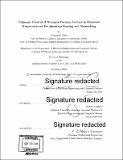| dc.contributor.advisor | Dirk R. Englund. | en_US |
| dc.contributor.author | Chen, Edward H. (Edward Hong) | en_US |
| dc.contributor.other | Massachusetts Institute of Technology. Department of Electrical Engineering and Computer Science. | en_US |
| dc.date.accessioned | 2017-03-10T15:05:22Z | |
| dc.date.available | 2017-03-10T15:05:22Z | |
| dc.date.copyright | 2016 | en_US |
| dc.date.issued | 2016 | en_US |
| dc.identifier.uri | http://hdl.handle.net/1721.1/107324 | |
| dc.description | Thesis: Ph. D., Massachusetts Institute of Technology, Department of Electrical Engineering and Computer Science, 2016. | en_US |
| dc.description | Cataloged from PDF version of thesis. | en_US |
| dc.description | Includes bibliographical references (pages 99-123). | en_US |
| dc.description.abstract | The exceptional optical and spin properties of the negatively charged nitrogen-vacancy (NV-) center in diamond have led to numerous applications ranging from super-resolution imaging to the exploration of previously untested new phenomena using quantum entanglement for information processing and sensing. The solid-state environment of the diamond allows us to engineer nanostructures, which are promising for enhancing the optical and spin properties of the NV-. To help develop a component needed for a diamond-based quantum network, we recently achieved coherent electron spin control of long-lived NV-s in diamond nanostructures using a transferrable hard-mask for both etching and ion implantation. We also developed a super-resolution imaging technique for characterizing such systems, and we furthermore demonstrate high-sensitivity electrometry using a large number of NV-s. However, it remains an open area of investigation whether certain nano-fabrication processes for patterning nanostructures into diamond cause irrecoverable damage or introduce atomic impurities to the crystal that would lead to a significant degradation of the NV- properties. Another remaining challenge is to produce fault-tolerant multi-qubit registers within nanostructures for improved robustness and scalability for use in compact quantum sensors or quantum networks. By building on the results in this thesis, it may be possible to design nanostructures for enhancing initialization, control and read-out fidelities of defect-based solid-state quantum technologies. | en_US |
| dc.description.statementofresponsibility | by Edward H. Chen. | en_US |
| dc.format.extent | 123 pages | en_US |
| dc.language.iso | eng | en_US |
| dc.publisher | Massachusetts Institute of Technology | en_US |
| dc.rights | MIT theses are protected by copyright. They may be viewed, downloaded, or printed from this source but further reproduction or distribution in any format is prohibited without written permission. | en_US |
| dc.rights.uri | http://dspace.mit.edu/handle/1721.1/7582 | en_US |
| dc.subject | Electrical Engineering and Computer Science. | en_US |
| dc.title | Coherent control of nitrogen-vacancy centers in diamond nanostructures for quantum sensing and networking | en_US |
| dc.type | Thesis | en_US |
| dc.description.degree | Ph. D. | en_US |
| dc.contributor.department | Massachusetts Institute of Technology. Department of Electrical Engineering and Computer Science | |
| dc.identifier.oclc | 972901123 | en_US |
